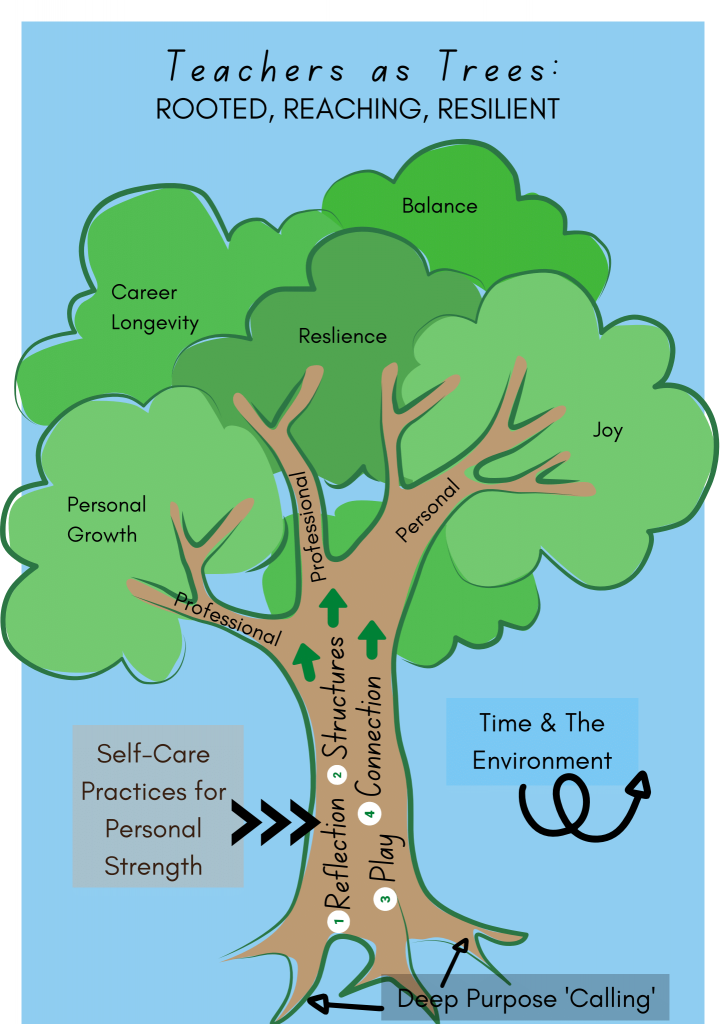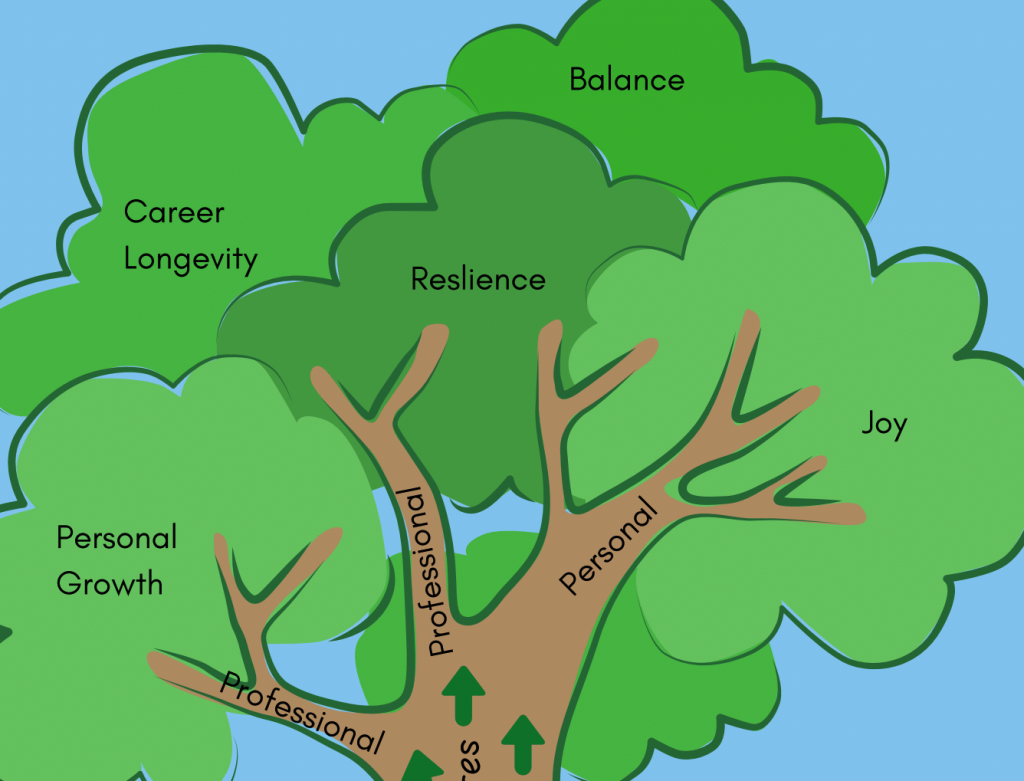Recently, a small study undertaken at University of Calgary determined four areas of wellness practice supporting
teachers in career longevity, as outlined in the narrative below.

As she pulls the door to her classroom shut, Carrie turns and all but bumps into Alex, the Spanish teacher. Nodding at the heavy bag on Carrie’s shoulder, Alex quips, “Looks like you’re in for a fun evening!”
“Uh, yup,” Carrie mutters, attempting to brush past the other teacher. Get to the car before you cry, she warns herself. Just keep going.
Alex extends a hand. “Wait. Carrie—I know. It’s a lot. Especially at first.”
Carrie’s eyes widen as she finds the other teacher’s level gaze, noting the crease of concern between Alex’s brows.
“Got a minute?” Alex nods toward the Spanish room.
“Sure,” Carrie stammers. “Look, I don’t want to hold you up…” Why does my voice have to quaver this way? Why am I feeling so stressed?
As the two teachers pull out a couple of student chairs, tears spring to Carrie’s eyes.
Alex hands her a tissue and lightly touches Carrie’s shoulder. “I was a new teacher once, you know. And I debated leaving after the first couple of years. About that time, I read an article saying mental health is a fundamental element of resilience, and something clicked (Friedli and the European World Health Organization, 2009). I decided to stay, but to put on my own oxygen mask first—to learn resilience. I had to take responsibility for choices I make; choices about my workload and how I handle the stress of this profession.”
Carrie lets out a long exhale, “At this point I will try anything.”
Alex smiles, “My favourite strategy is to take a few moments once in a while to just stare out the window at a tree or a cloud—whatever’s natural or beautiful. Let my thoughts reflect on something positive and breathe deeply, slowly.” Alex demonstrates; Carrie can sense her own tension loosening as she follows suit. “Some people might call it prayer or mindfulness,” continues Alex. “Whatever you call it, that reflection helps me blow out the mental fog.”
Carrie nods. “Simple enough. I can try that.”
A cheery voice calls from the hall, “Hey Alex! You still here? Just thought I’d see if …. Oh. Sorry.”
Carrie looks up to see the veteran Math teacher, Kris, framed in the door.
Kris looks at her with concern. “Sorry to intrude. Hey—you look a bit …. Whoa! You’re packing quite a load.” Kris points at the bag slumped at Carrie’s feet.
Carrie hesitates. “I am,” she admits ruefully. “In so many ways.”
Alex waves Kris into the room. “You’ve been in this profession over ten years, Kris. How do you deal with the demands of teaching?”
“That’s easy: being connected. Friends, colleagues, my family. Number one support group: they all help me keep perspective. Oh, and I organize,” Kris grins. “I need structure. Like, systems, processes, to-do lists. Love those—makes me feel like I have some control. They help with resilience, which makes me more effective, and that makes me feel better about my job—straight-up helps me deal—every day” (Bobek, 2002).
Alex nods. “Connecting. Me too: my dog, my kids. And I do love lists … and cat videos.”
Carrie smiles at that. “My guilty pleasure.”
“Right! You can’t forget to play,” Alex continues. “Volleyball beer league and mornings on my treadmill get me moving.”
“Ugh.” Carrie grimaces. “I suck at volleyball. But I do have a dog. Who is definitely under walked. I should do more of that. And I’m also a big fan of to-do lists.”
Alex walks to the whiteboard. “Time to get you home. First, a quick review, since we all like lists.” Alex writes STRUCTURE on the board. “Obviously, this means lists, setting boundaries— like how much marking comes home, and managing your time. How about walking the dog, volleyball ….”
Carrie raises an eyebrow at Kris, who adds, “Skiing, paddle boarding ….”
Alex then writes PLAY in block letters.
“And your breath thing,” Carrie offers.
“Right. But it’s more than that. It’s kind of a pause and ….” Alex jots: REFLECT.
Kris walks to the whiteboard. “Don’t forget family, friends, and colleagues. The people you love, the ones who support you.” Alex hands over the pen, and Kris writes CONNECT.
Alex appraises the list. “What do you think, Carrie? Do-able?”
Carrie inhales, drops her shoulders and smiles broadly for the first time in days. “Definitely do-able.”
“Consider it your homework,” Alex says wryly. “Instead of that big sack of marking. Give yourself the evening off.”
Carrie stands. “You know, I think I will. Thanks—both of you.” She studies the list. “Just four things: structure, play, reflect, connect— easy. Ish.”
Alex and Kris wait as Carrie takes the marking back to her desk, where the stack lands with a satisfying thump. Carrie feels herself walking taller as the three teachers, chatting lightly, stroll down the hall, out the doors and into the parking lot.
As she inserts her key into the ignition, Carrie ponders their conversation. It’s clear she must take control of her own well-being to have the long teaching career she’s dreamt of (Simmons et al., 2019).
Four things, she thinks, pausing at a red light. Four things that, like the trunk of a tree, will help me stand straight and flourish. She considers the calling she once felt so strongly. If I’m a tree, that sense of purpose is my roots. Carrie imagines herself as a beautiful, leafy tree: rooted, reaching, resilient. She smiles. She will go home, walk the dog, call her mom, maybe have a long, hot, bath. The light turns green. Carrie drives on.
References
Bobek, B. L. (2002). Teacher Resiliency: A Key to Career Longevity. The Clearing House: A Journal of Educational Strategies, Issues and Ideas: Teacher Renewal, 75(4), 202–205. https://doi.org/10.1080/00098650209604930
Friedli, L & World Health Organization. (2009). Mental health, resilience and inequalities. https://apps.who.int/iris/handle/10665/107925
Simmons, M., McDermott, M., Lock, J., Crowder, R., Hickey, E., DeSilva, N., Leong, R., & Wilson, K. (2019). When Educators Come Together to Speak About Well-Being: An Invitation to Talk. Canadian Journal of Education, 42(3), 850–872.
Shulyakovskaya, L. (2017) Why Are Millennial Teachers Leaving? University of Calgary Research @ Werklund https://werklund.ucalgary.ca/wse-research/home/research-werklund/why-are-millennial-teachers-leaving
Kim Desmarais
Kim Desmarais is an educator and lifelong learner. Her teaching career spans twenty years. She is currently an elementary school vice-principal in Castlegar, BC. Kim completed her Masters of Education at University of Calgary, focusing on Educational Neuroscience, Inclusion and Teacher Wellness. She believes educators best meet the needs of all learners by modeling mental and physical wellness by thriving, not simply surviving.
Leslie Beaton Hedley
Leslie Beaton Hedley is an educator and writer from Calgary, AB. She has been teaching for ten years. She recently earned an MEd from University of Calgary’s Werklund School of Education, with a focus on Creativity in Educational Practice, Mindful Leadership and Teacher Wellness.
Antonia Kousouris Leask
Antonia Kousouris Leask has been an elementary school teacher for more than fifteen years. She teaches in a grade 3/4 classroom at Capitol Hill School in Calgary, AB, where she is Literacy and Indigenous Learning lead teacher. She is a recent graduate of the University of Calgary’s MEd program, with a focus on Educational Neuroscience, Mindful Leadership, and Teacher Wellness. She is a wife and mother of two school-age children who motivate and support her in lifelong learning.
This article is featured in Canadian Teacher Magazine’s Spring 2022 issue.

